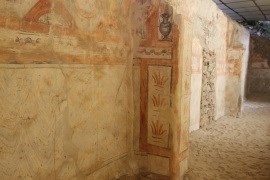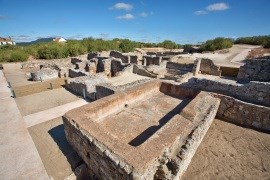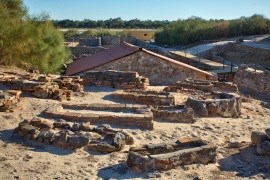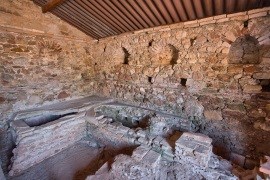|

BASÍLICA

Um dos monumentos mais bem conservados do sítio arqueológico de Tróia é a Basílica paleocristã, uma igreja construída em finais do século IV ou inícios do século V.
Era um edifício de grande dimensão com três arcadas dividindo o espaço em quatro naves transversais. As suas altas paredes estão profusamente pintadas com motivos geométricos e vegetais, bem como imitação de mármore. Um crísmon desaparecido, símbolo cristão da época de Constantino, foi registado no topo de uma parede, identificando este edifício como cristão. Um cântaro pintado num pilar é outro dos temas muito utilizado pelas comunidades cristãs mais antigas. A Basílica foi construída sobre uma oficina de salga abandonada, que fora transformada em cemitério.
OFICINAS

As oficinas de salga de peixe de Tróia são compartimentos com tanques à volta de um pátio. O maior complexo fabril a descoberto integrava, nos séculos I e II, duas oficinas interligadas e um armazém, não se conhecendo ainda todas as suas dependências e a sua extensão total.
Até à data, foram identificadas vinte e cinco oficinas de dimensões muito variadas. A maior tinha 1106 m2 e os seus dezanove tanques já escavados tinham uma capacidade de produção de cerca de 465 m3. A mais pequena oficina completa a descoberto tinha apenas 135 m2 e os seus nove tanques tinham uma capacidade de produção de cerca de 103 m3.
RUA DA PRINCESA

Nos séculos XVIII e XIX foi posto a descoberto uma área residencial com edifícios alinhados que ficou conhecida como Rua da Princesa por causa dos trabalhos que aqui mandou fazer a Infanta D. Maria Francisca, futura Rainha D. Maria I.
Segundo a mais recente interpretação, estas construções pertenciam a uma grande casa com rés-do-chão e primeiro andar que à data da escavação ainda tinha restos de pavimentos em mosaico e pintura mural.
TERMAS

As termas postas a descoberto em Tróia estão encostadas à maior oficina de salga e ocupam uma área com cerca de 450 m2. Eram abastecidas por água de um poço que era conduzida por um pequeno aqueduto a um reservatório de água de onde era distribuída para os tanques.
Têm as partes habituais numas termas romanas: uma zona quente (caldarium) com um sistema de aquecimento subterrâneo e pequenos tanques para banhos de vapor e de água quente, uma sala de transição com temperatura morna (tepidarium), uma zona fria (frigidarium) com dois pequenos tanques para banhos de água fria e ainda um vestiário (apodyterium) e uma sala de entrada para convívio e exercício físico (palaestra).
NECRÓPOLES

A grande diversidade de sepulturas nas quais os habitantes de Tróia enterraram os seus mortos é um reflexo da continuidade da ocupação do sítio ao longo de vários séculos. Revela ainda um intenso contacto com o exterior que lhes foi permitindo adoptar os novos usos e costumes que se iam propagando pelo Império.
Existiram pelo menos 4 necrópoles na Tróia romana e um mausoléu: a necrópole da Caldeira, escavada nas décadas de 40 e 50 do século XX, datável do século I ao século V; a necrópole da basílica que datará dos séculos IV-V; a necrópole das sepulturas de mesa, a sudoeste da basílica, que poderá ser a continuação da necrópole desse complexo e a necrópole do mausoléu, que preencheu o interior deste edifício e se prolongou para o seu exterior provavelmente no século V.
MAUSOLÉU

O mausoléu foi construído junto a uma oficina de salga, sobre um armazém de ânforas da primeira fase de produção de salgas, e pensa-se que seja dos inícios do século III.
É um edifício rectangular com paredes com fiadas de pedras entremeadas com fiadas de tijolos, e contrafortes no exterior das paredes laterais. No interior, as paredes tinham nichos para colocar potes com as cinzas de defuntos, segundo a prática tradicional romana da cremação. No entanto, neste edifício funerário a cremação conviveu com a inumação, visto que o seu interior foi preenchido com sepulturas de vários tipos, destacando-se algumas grandes arcas sepulcrais bastante elaboradas, feitas com tijolos e cobertura de argamassa.
|

BASILICA

One of the best preserved buildings of the archaeological site of Tróia is the early Christian basilica, a church built in the late 4th or early 5th c. It was a large building with three arcades dividing the space in four transversal naves. Its high walls are profusely painted with geometric and vegetal motifs as well as marbled. A disappeared chrism, Christian symbol that appeared in the Constantine period, was registered on the top of a wall identifying this building as Christian. A cantharus painted in a pillar is another theme much used by the oldest Christian communities. The basilica was built over an abandoned fish-salting workshop that had been turned into a cemetery.
WORKSHOPS

The fish-salting workshops of Tróia are compartments with vats around a patio. The largest factory uncovered so far would include, in the 1st and 2nd c., two connected workshops and a storeroom, but other dependencies and its full extension are yet to be assessed.
To this day, twenty five workshops of various dimensions have been identified. The largest one covers an area of 1106 m2 and its excavated nineteen vats had a production capacity of 465 m3. The smallest workshop only covers an area of 135 m2 and its nine vats had a production capacity of about 103 m3.
PRINCESS STREET

In the 18th and 19th c., a residential area with lined buildings was uncovered. It has been known to this day as Princess’ street due to the works that Princess Maria Francisca, later Queen D. Maria I, ordered in this area.
According to the most recent interpretation, these constructions belonged to a large house with a ground floor and a second storey. When it was excavated, the second storey debris included fragments of mosaic pavements and wall paintings.
BATHS

The baths uncovered at Tróia are next to the largest fish-salting workshop and cover an area of about 450 m2. They were supplied by a well nearby and the water was channeled through a small aqueduct to a reservoir from where it was distributed to the pools through lead pipes.
These baths have the typical spaces of Roman bath complexes: a heated area (caldarium) with an underground heating system and small pools for steam and hot water bathing; a mid- temperature room of transition (tepidarium); a cold temperature area (frigidarium) with two small pools for bathing; a dressing-room (apodyterium) and a room next to the entrance room for exercising and socializing (palaestra).
CEMETERIES

The great diversity of tombs in which people buried their dead reflects the continuous occupation of the site for several centuries. Moreover it reveals the intense interchange with the exterior that led them to gradually adopt the new customs that were propagated along the Empire.
There were at least four cemeteries and a mausoleum in Roman Tróia: the Caldeira cemetery, excavated in the 40’s and 50’s of the last century, dating from the 1st to the 5th c.; the basilica cemetery dating to the 4th-5th c., the mensa tombs cemetery, southwest of the basilica, that may be the continuation of the basilica cemetery; and the mausoleum necropolis that filled the inside of that building and extended to the outside probably in the 5th c.
MAUSOLEUM

The mausoleum was built next to a fish-salting workshop, over an amphora storehouse from the first production phase, in the 1st and 2nd c., and it is believed to have been built in the early 3rd c.
It is a rectangular building with walls made of stone rows and brick rows and it has buttresses holding the lateral walls. Inside the walls have niches where urns would have been placed with the ashes of the deceased, according to the traditional Roman practice of incineration. Yet in this funerary building incineration was side by side with inhumation since on the ground tombs were built for burying corpses in graves. Some large elaborated sepulchral arks made of brick with mortar covers stand out.
|